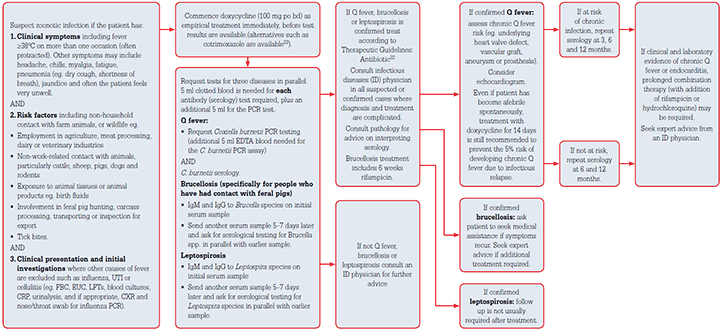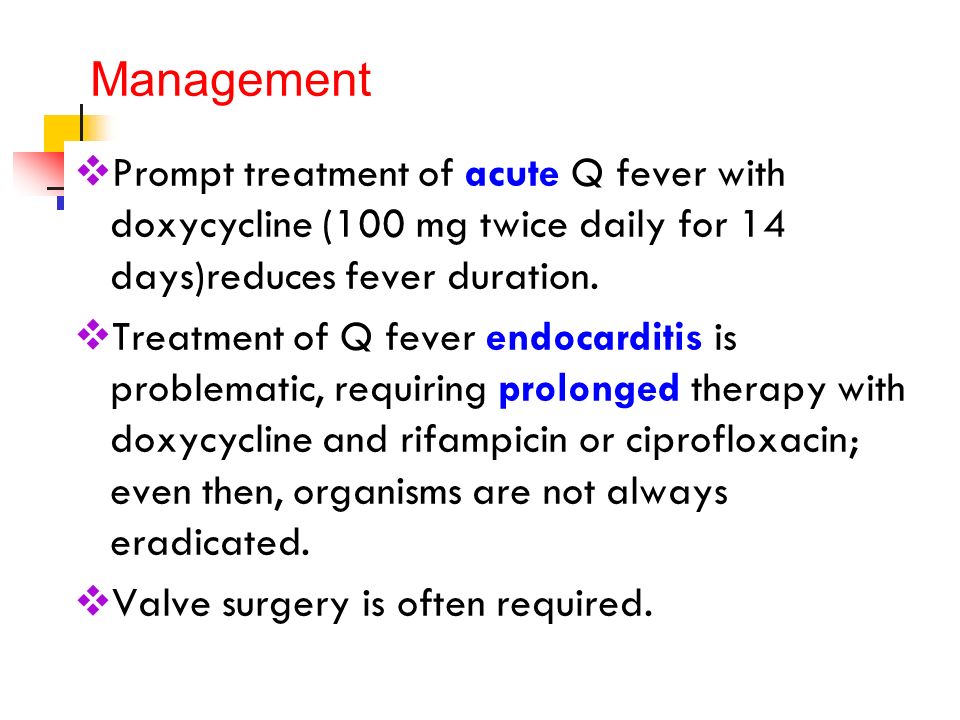Q Fever Therapy
This questionnaire is provided for internal use by organisations offering Q Fever Screening and Vaccination programs. Q fever is caused by the bacterium Coxiella burnetii and has both acute and chronic forms.
Antibiotic treatment is the most effective one for Q fever.

Q fever therapy. Chronic Q fever requires prolonged antimicrobial therapy and close follow-up care with an infectious disease specialist. Q fever is a zoonotic bacterial disease caused by Coxiella burnetii. Chronic Q fever often requires the use of multiple drugs usually doxycycline in combination with hydroxychloroquine.
It is not required by the Australian Q Fever Register and organisations are encouraged to seek legal advice on their. Current aspects of aetiology epidemiology human infection diagnosis and therapy. Q fever in Europe.
Chronic Q fever is a zoonosis caused by the intracellular coccobacillus Coxiella burnetii 1 2. Shortly after discovery of C. Q fever is a zoonosis caused by Coxiella burnetii an obligate gram-negative intracellular bacterium.
Q fever developed in 7 LCT recipients from Canada Germany and the United States. In the 1950s Q fever endocarditis was first recognized 4 5. Four patients were given antibiotic treatment when Q fever was confirmed by serology.
If used as a biological weapon it is likely to cause low mortality but high acute morbidity. The normal therapy for the acute disease is a 2 week course. Q fever endocarditis patients generally receive therapy for several months.
Antibiotic therapy is used to treat individuals with Q fever. Based on the recent knowledge on Q fever we review here the clinical practices from Q fever diagnosis to therapy. The approach to treatment for Q fever depends primarily upon the presence of acute or persistent localized disease and the patients comorbid conditions 3.
The acute disease is a febrile illness often with headache and myalgia that can be self-limiting whereas the chronic disease typically presents as endocarditis and can be life threatening. Courses of antibiotic treatment with a combination of two drugs were maintained for four to six years and in three of these patients phase I antibody titres fell to very low levels with no appearance of. However when Q fever is diagnosed the administration of antibiotics is appropriate to prevent progression.
During an outbreak of Q fever in Germany we identified an infected sheep flock from which animals were routinely used as a source for life cell therapy LCT the injection of fetal cells or cell extracts from sheep into humans. During SeptemberOctober 2014 the New York State Department of Health identified Q fever in five patients with exposure to a treatment known as live cell therapy an alternative medicine practice involving injections of fetal sheep cells which is a type of xenotransplantation. This worldwide zoonotic disease caused by the bacterium Coxiella burnetii also affects several domestic and wild mammal species birds and arthropods which can serve as reservoirs.
Some mild cases of Q fever may improve without treatment although antibiotic therapy usually reduces the duration of the infection. Q fever occurs either as an acute form or a severe chronic form following an early infection that may go unnoticed. Tumor necrosis factor-alpha TNF-α plays a pivotal role in the defense against infection with this Gram-negative coccobacillus.
However our highly knowledgeable caregivers can take care of every patient according to their current conditions and symptoms. Four major critical points are highlighted in this review. The acute form resolves quite quickly after appropriate antibiotic therapy but the chronic form requires prolonged antibiotic therapy for 2 years or more coupled with serological monitoring.
Frequent relapses 50 are observed despite adequate therapy and this disease carries mortality rates that can exceed 60. Following the 2007-2010 Q-fever outbreak in the Netherlands with over 4000 notified cases the emphasis on long-term consequences of Q-fever increased. The objective of the recently published national guideline Q fever fatigue syndrome QFS is to achieve uniformity in its diagnosis and treatment.
Burnetii it was found that penicillin was not beneficial as treatment for Q fever which is in contrast to tetracyclines TET. Edward Holbrook Derrick among abbatoir workers in Queensland Australia. See Acute Q fever below and Persistent localized disease below and.
The recommendation is to refer patients with QFS to specialists who offer cognitive behavioural therapy for chronic fatigue syndrome or QFS. The aim of this study was to provide an overview of all relevant available literature and to identify knowledge gaps regarding the definition diagnosis background description aetiology prevention therapy and prognosis of fatigue following acute Q-fever. Q fever treatment is a challenging aspect that needs supervised care and gentle therapy.
We searched PubMed and Google Scholar to perform the qualitative synthesis. Human cases of Q fever and fresh cell therapy in Germany 15 October 2015 3 York who travelled in a group of 1015 people to the state of Rhineland-Palatinate in Germany to receive the same injections of foetal sheep cells on 28 May 2014. Although specific antimicrobial therapy is indicated most patients improve spontaneously.
Theoretically patients who are treated with anti-TNF-α. Involves presumptive antibiotic therapy. The first point is that Q fever diagnosis has been reviewed in.
Physicians recommend that all individuals in whom Q fever is detected receive antibiotic therapy even those with no recognizable clinical findings subclinical disease. In December 2014 the Paul Ehrlich Institute reported in the Bulletin for Drug Safety Bulletin Zur. 3 27 EMEA 2002 General points on treatment Q fever is a zoonosis caused by Coxiella burnetii an obligate intracellular gram-negative bacterium with high infectivity but with relatively low virulence.
Doxycycline is the treatment of choice for acute Q fever. Q fever was first described in 1937 by Dr.
/overview-of-q-fever-4177937_color1-5c454c4bc9e77c000153bca5.png)
Q Fever Symptoms Causes And Treatment

Natural History And Pathophysiology Of Q Fever The Lancet Infectious Diseases
/overview-of-q-fever-4177937_color1-5c454c4bc9e77c000153bca5.png)
Q Fever Symptoms Causes And Treatment

The Principles And Practice Of Q Fever The One Health Paradigm Nova Science Publishers

Community Onset Pneumonia Emcrit Project Pneumonia Adjuvant Therapy Community Acquired Pneumonia
/8904921198_8858d1fbf8_k-5bef1498c9e77c005178a580.jpg)
Q Fever Symptoms Causes And Treatment

Recurrent Pericarditis Treatment Download Table

Causes Of Fulminant Hepatic Failure Download Scientific Diagram

Natural History And Pathophysiology Of Q Fever The Lancet Infectious Diseases

Racgp Diagnosis And Management Of Zoonoses A Tool For General Practice

Prolonged Febrile Illness And Fever Of Unknown Origin In Adults American Family Physician

Natural History And Pathophysiology Of Q Fever The Lancet Infectious Diseases

Rickettsial Infections Ppt Video Online Download

Natural History And Pathophysiology Of Q Fever The Lancet Infectious Diseases
Posting Komentar untuk "Q Fever Therapy"